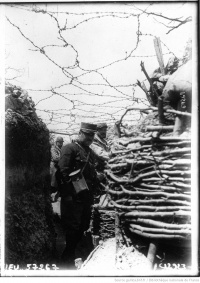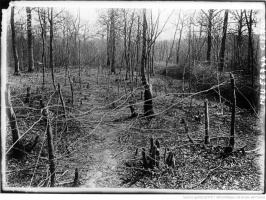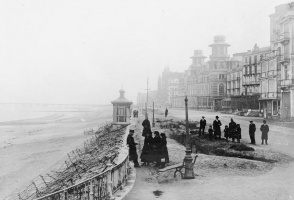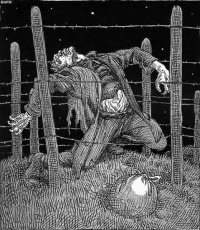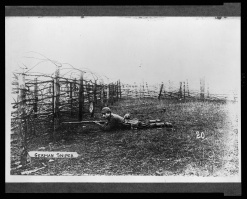“To keep in and to keep out”↑
Barbed wire’s simplicity of concept and ease of realization belies the critical role it has played in the modern experience: territorial expansion and settlement, regional and international conflicts, incarceration and extermination. Barbed wire’s singular purpose - to keep in and to keep out - was first put to use on the Great Plains of the American West in the late 19th century to restrict cattle and, implicitly, to secure territory by expansionist settlers and demarcate possessions. Important patents were issued to Henry M. Rose on 13 May 1873, and Joseph Glidden (1813-1906) on 24 November 1874 (a patent famously called “The Winner”). Barbed wire’s utilization in this rural economy led to hostility amongst the settlers themselves (the short-lived Range Wars, 1883-1884), and also to tension between the settlers and Native Americans - the latter of whom saw their open ranges dissected by barbed wire. American patents were predated by ones awarded to Gilbert Gavillard on 27 August 1867, a little-known French (Breton) brick manufacturer and, even earlier on 7 July 1860, to Léonce Eugène Grassin-Baledans, who had in mind “everything that ought to be enclosed or fenced,” including railings for parks, railroads, meadows, gardens and trees.
Modern Warfare↑
Barbed wire’s transformation from this mixed economy into the mechanized landscape of modern warfare would transform its symbolic meanings forever while still retaining its original purpose to “keep in and keep out”. Widely used for the first time in South Africa by the British General Horatio Herbert Kitchener (1850–1916) against the Boers of the Transvaal and the Orange Free State (in the so-called Second Boer War, 11 October-31 May 1902), it was Lord Kitchener who turned to a strategy of barbed wire and blockhouses that paralleled his other initiative, also involving barbed wire; the construction of what soon came to be called “concentration camps”, a term that would enter menacingly into the social imagination with the Nazi death camps of the Second World War, such as Belzec and Treblinka. Here barbed wire, now electrified, became an essential part of the architecture of mass murder. In the Russo-Japanese War of 1904-05, barbed wire was employed in conjunction with trenches, redoubts, glacis (banks sloping down in front of defensive positions), and fougasses (small mines placed underground with gunpowder or loaded shells).
The Great War↑
The scale and complexity of trench fortifications in the so-called Great War (stretching for nearly 1,300 miles), however, were unprecedented; and it was this that allowed barbed wire to play out its new and frightening role. Described phlegmatically in a British manual as the “most efficient obstacle and [one that is] universally used”, barbed wire and its dreadful effects were picked up and lampooned by British troops in the lyrics of The Old Barbed Wire, a popular World War I song: “If you to want to find the sergeant, /I know where he is, /... I’ve seen him… /Lying on the canteen floor... /If you want to find the old battalion, /I know where they are, /They’re hanging on the old barbed wire. /I’ve seen ‘em, I’ve seen ‘em, /...”[1] The German war veteran and author, Erich Maria Remarque (1888–1970), would later allude to such “hangings” in his famous novel of 1928, Im Westen nichts Neues. Published in 1929 in English as All Quiet on the Western Front, Remarque writes: “We recognise the distorted faces and the flattened helmets — it’s the French...the body falls away completely and only the shot-off hands and the stumps of the arms are left hanging in the wire.”[2]
Alan Krell, The University of New South Wales
Section Editor: Catriona Pennell
Notes
Selected Bibliography
- Bourne, J. M.: A personal reflection on the two world wars, in: Liddle, Peter / Bourne, J. M. / Whitehead, Ian R. (eds.): The Great War 1914-1945. Lightning strikes twice, volume 1, London 2003: HarperCollins, pp. 13-26.
- Krell, Alan: The devil's rope. A cultural history of barbed wire, London 2002: Reaktion Books.
- McCallum, Henry De Rosset / McCallum, Frances Tarlton: The wire that fenced the West, Norman 1965: University of Oklahoma Press.
- Netz, Reviel: Barbed wire. An ecology of modernity, Middletown 2004: Wesleyan University Press.
- Razac, Olivier: Histoire politique du barbelé. La prairie, la tranchée, le camp, Paris 2000: La Fabrique.





